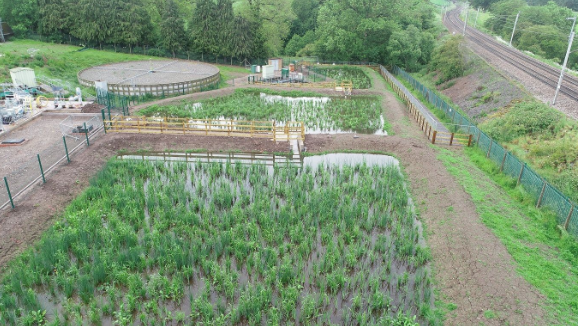14 Aug 2023
Wetlands for wastewater: Harnessing the power of nature

We’re utilising the power of nature to combat climate change and improve rivers in Cumbria. More than 4,000 reed plants are taking root in a wetland design which is helping us treat excess storm water during heavy rainfall.
Simon Holding, Area Business Manager, tells us more about the wonder of wetlands and how they’re helping transform treatment in Southwaite.
Tell us more about how the wetlands came to be at a treatment works in Cumbria?
Southwaite wastewater treatment works can be found just outside of Carlisle and it’s recently been upgraded to incorporate revolutionary nature-based storm water treatment techniques, as part of a £7 million project.
This is the first time in the North West that a wetland has been used to manage storm water. The reeds were planted over more than 1,500 square metres – that’s the size of six tennis courts. These come into action during heavy rainfall when excess storm water bypasses the treatment plant when it is running at full capacity. The reeds manage flood risk and use natural processes to clean the small particles in the storm water before it enters the river.
What is unique about the upgraded Southwaite WwTW?
Keen to minimise carbon – from both construction and operation - we discounted the use of traditional storm overflows early on and opted for a nature-based treatment solution.
This was the first time we had used such an approach. Initially, other nature-based treatment solutions like vertical flow aerated reed beds and horizontal flow reed beds were considered, but a wetland was ultimately chosen due to its enhanced biodiversity and lower environmental impact.
Wetlands have the natural capacity to store excess water during heavy rainfall events, helping to reduce the risk of flooding. They are also efficient carbon sinks, trapping and storing carbon dioxide from the atmosphere. This can contribute to climate change mitigation efforts by reducing greenhouse gas emissions.
Wetlands also reduce levels of phosphate entering the river, a substance which can cause algae to grow too quickly in watercourses, stifling other wildlife.
How was the wetland designed and constructed?
More than 4,000 baby reed plants were planted in three giant pond liners to create marshy wetland. Most of the wetland is filled with soil recycled from the construction of the main works. This method allows cells to naturally aerate the stormwater, helping the pre-existing plants to flourish.
The plants in the wetland were carefully selected to provide maximum treatment capacity and biodiversity. Even the embankments are planted with a wildflower seed mix to encourage the local ecosystem to thrive and create an attractive habitat for people to visit.
Over time it is expected that the maintenance of the wetland will be minimal as the plants will naturally evolve and mother nature takes over.
What else does this offer the community?
Wetlands provide a habitat for a variety of plant and animal species. Encouraging this biodiversity to flourish not only contributes to the overall health of the ecosystem but also can have a positive impact on the treatment process. Some species help control pest populations, while others contribute to nutrient cycling and ecological balance.
Wetlands also offer recreational opportunities for the local community, such as bird-watching, nature walks, and educational activities. We hoped to foster a sense of environmental stewardship and so were keen to make the wetland as accessible as possible to the public.
As part of the project, low level fencing, footpaths and viewing areas have been added to encourage local engagement with the wildlife as it establishes itself over the next few years.
What’s next?
The Southwaite Wastewater Treatment Works stands as a pioneering initiative - enhancing the current wastewater treatment facility situated in Southwaite, as it services the small rural village in Cumbria and the nearby M6 Motorway Services.
It’s hoped we can now duplicate the project and look to nature-based solutions as upgrades to wastewater treatment works take place across the North West.